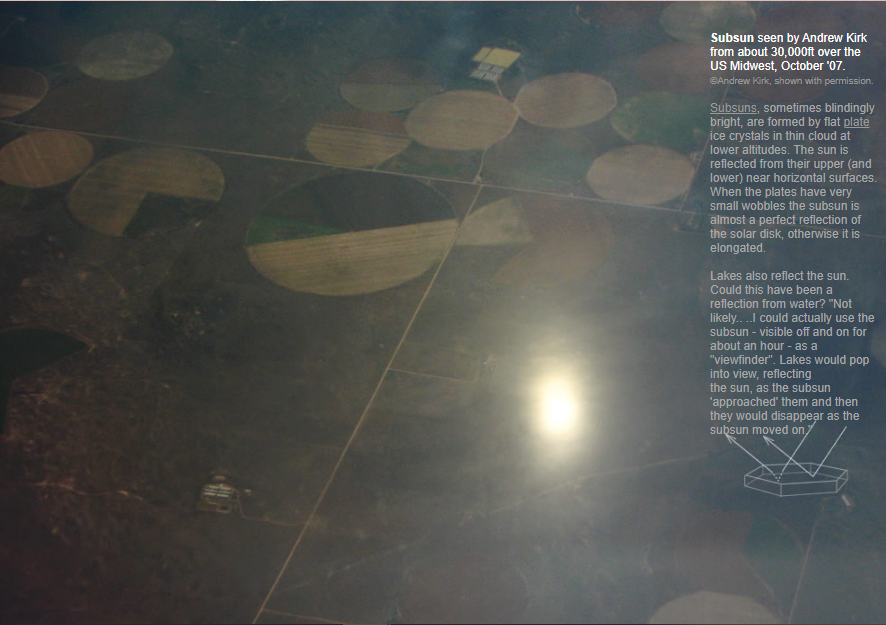Midwest Subsun
Midwest Subsun: A Phenomenon of Atmospheric Optics
Have you ever witnessed a subsun? These fascinating optical phenomena occur when flat plate ice crystals in thin clouds at lower altitudes reflect the sun's rays, creating a mesmerizing spectacle in the sky. One such remarkable subsun was captured by Andrew Kirk from an altitude of approximately 30,000 feet over the US Midwest in October 2007. The image he captured showcases the blinding brightness and beauty of this atmospheric occurrence.
Subsuns are formed when sunlight is reflected from the upper and lower near-horizontal surfaces of these ice crystals. When the flat plates possess very slight wobbles, the subsun appears as an almost perfect reflection of the solar disk. However, if the plates exhibit more pronounced wobbles, the subsun may appear elongated.
The question arises: could this subsun have been a reflection from a body of water, such as a lake? According to Andrew Kirk, it is highly unlikely. He explains that he was able to utilize the subsun as a "viewfinder" for observing lakes. As the subsun approached them, the lakes would come into view, reflecting the sun's rays. Conversely, as the subsun moved on, the lakes would disappear. This observation suggests that the subsun phenomenon is distinct from mere reflections on water surfaces.
To delve deeper into the intricacies of subsuns, it is important to understand the role of flat plate ice crystals in their formation. These ice crystals typically have a hexagonal shape and are characterized by their relatively flat and smooth surfaces. The orientation and alignment of these crystals play a crucial role in determining the appearance and characteristics of the subsun.
Here are some key points to consider about subsuns:
-
Formation: Subsuns are primarily formed in thin clouds at lower altitudes where flat plate ice crystals are present. These clouds may be composed of water droplets or ice particles.
-
Sunlight Reflection: The subsun phenomenon occurs when sunlight is reflected from the upper and lower surfaces of these flat plate ice crystals. The reflection creates a stunning optical illusion resembling a second sun in the sky.
-
Optical Characteristics: The appearance of a subsun can vary depending on the orientation and alignment of the ice crystals. If the crystals have minimal wobbles, the subsun will closely resemble the solar disk. However, if the crystals exhibit more pronounced wobbles, the subsun may appear elongated.
-
Distinct from Water Reflections: Unlike reflections on water surfaces, subsuns can be used as a "viewfinder" to observe lakes. As the subsun approaches a lake, it comes into view, reflecting off the water's surface. Conversely, as the subsun moves away, the lake disappears from view.
-
Atmospheric Conditions: Subsuns are more commonly observed in regions with thin cloud cover and lower altitudes. The presence of flat plate ice crystals is essential for their formation.
-
Midwest Subsun: The Midwest Subsun captured by Andrew Kirk in October 2007 serves as a remarkable example of this optical phenomenon. The image showcases the intense brightness and clarity of the subsun, providing valuable insights into its characteristics.
-
Photographic Challenges: Capturing the true beauty of a subsun can be challenging due to its intense brightness. Specialized techniques and equipment may be required to accurately represent its appearance in photographs.
-
Scientific Interest: Subsuns are not only visually captivating but also of scientific interest. Studying their formation and characteristics can provide valuable insights into atmospheric optics and the behavior of ice crystals in different atmospheric conditions.
-
Educational Value: The occurrence of subsuns offers an excellent opportunity for educational outreach and public engagement in the field of atmospheric optics. Sharing images and information about subsuns can help raise awareness and foster curiosity about the natural wonders of our atmosphere.
-
Continued Research: Despite our understanding of subsuns, there is still much to learn about their formation and behavior. Ongoing research and observation can contribute to a deeper understanding of this captivating atmospheric phenomenon.
In conclusion, the Midwest Subsun captured by Andrew Kirk offers a glimpse into the captivating world of atmospheric optics. The formation and characteristics of subsuns continue to intrigue scientists and enthusiasts alike. By studying these optical phenomena, we gain valuable insights into the behavior of ice crystals in the atmosphere and the mesmerizing displays they create.

Subsun seen by Andrew Kirk from about 30,000ft over the US Midwest, October '07. ©Andrew Kirk, shown with permission.
Subsuns, sometimes blindingly bright, are formed by flat plate ice crystals in thin cloud at lower altitudes. The sun is reflected from their upper (and lower) near horizontal surfaces. When the plates have very small wobbles the subsun is almost a perfect reflection of the solar disk, otherwise it is elongated.
Lakes also reflect the sun. Could this have been a reflection from water? "Not likely.. ..I could actually use the subsun - visible off and on for about an hour - as a "viewfinder". Lakes would pop into view, reflecting
the sun, as the subsun 'approached' them and then they would disappear as the
subsun moved on."
Note: this article has been automatically converted from the old site and may not appear as intended. You can find the original article here.
Reference Atmospheric Optics
If you use any of the definitions, information, or data presented on Atmospheric Optics, please copy the link or reference below to properly credit us as the reference source. Thank you!
-
<a href="https://atoptics.co.uk/blog/midwest-subsun/">Midwest Subsun</a>
-
"Midwest Subsun". Atmospheric Optics. Accessed on April 27, 2024. https://atoptics.co.uk/blog/midwest-subsun/.
-
"Midwest Subsun". Atmospheric Optics, https://atoptics.co.uk/blog/midwest-subsun/. Accessed 27 April, 2024
-
Midwest Subsun. Atmospheric Optics. Retrieved from https://atoptics.co.uk/blog/midwest-subsun/.